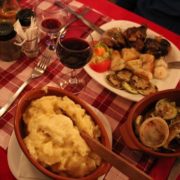Product Description
Kačamak is a dish of only few ingredients. There are two main subregional varieties. In both cases the main ingredient is flour. One variation-tučenjak, uses wheat flour and potatoes, the other only corn flour. The flour is cooked to get a porridge-like consistence. After that, it is greased with animal fat, kajmak (cheese fat) and mature white cheese. There is a kind of rivalry between subregions of Montenegro regarding which type tastes better.
Several chroniclers in the past two centuries mention kačamak as a typical highlanders’ dish. It is believed that tučenjak was invented soon after bishop Petar I Petrovic Njegos introduced potatoes to Montenegro in 1786. In that time, highland regions weren’t lacking only in potatoes and dairy products, so they added those ingredients to the flour, which was scarce, in order to make a dish of nutritional value sufficient for the whole family. In those times, everyday activities required hard work and lots of energy, and this dish provided a lot of it. Chronicles were stressing that this is the only Montenegrin dish in whose preparation men took part, as the process requires a lot of strength.
Once a peasants’ food, the symbol of Montenegrin fight against poverty, nowadays kačamak is a valued traditional dish that is an unavoidable item on menus in national cuisine restaurants, business lunches, fairs representing Montenegro…
There are two main varieties of kacamak, depending on the subregion. Tučenjak variety is typical for the Central North region. It is made by adding wheat flour to boiling potatoes. After that, a wooden tool is used to beat the ingredients until a smooth mass is obtained. This is a part that requires some strength, skills and patience. The name “tučenjak” means “the beaten kačamak”.
After beating, melted lard or tallow is poured over this mass. In another pan, cheese and kajmak are melted, and added to the top of the flour-potato mass. Most commonly used cheese is leafy cheese. Tučenjak has a smooth consistency, with strings of leafy cheese.
The other type of kačamak is typical for the East North subregion. This type is prepared by cooking corn flour for up to an hour, and then mixing it well until the porridge-like consistence is obtained. Fat, cheese and kajmak are added later. Corn kačamak has a grainy texture from the coarsely ground corn flour.
The exact proportions of ingredients vary slightly from one part to the other, so you won’t find two kačamaks of the same taste. Whatever the variety, this dish gives a strong sense of satiety, as it is high in energy.
Kačamak is typically served on wooden plates and consumed with yoghurt.






